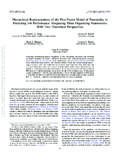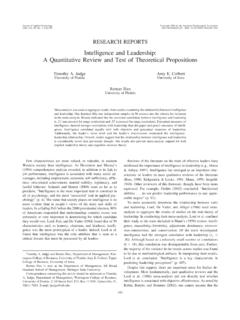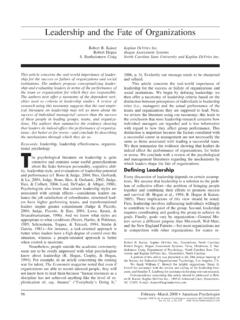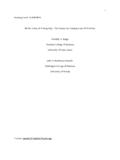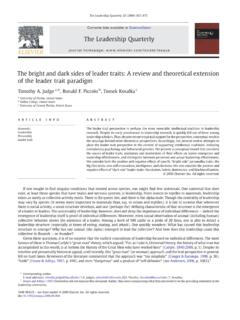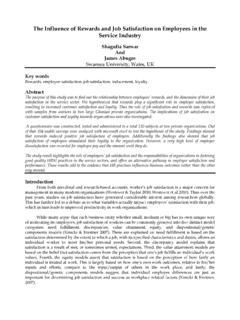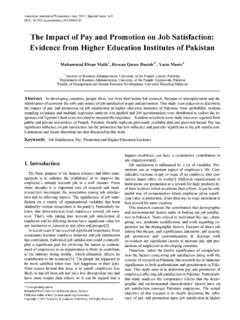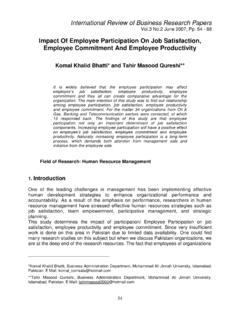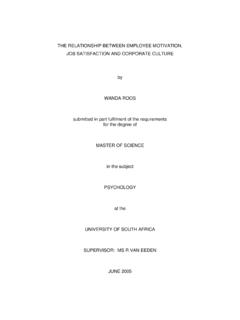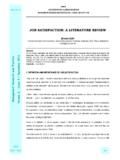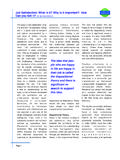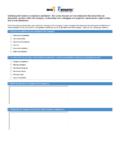Transcription of The Job Satisfaction-Job Performance Relationship: …
1 Psychological Bulletin2001, Vol. 127. No. 3. 376-407 Copyright 2(X)1 by the American Psychological Association, Inc.(XB3-2909/01 DOI: Job Satisfaction-Job Performance Relationship: A Qualitative and Quantitative ReviewTimothy A. JudgeUniversity of IowaCarl J. ThoresenTulane UniversityJoyce E. BonoUniversity of IowaGregory K. PattonUniversity of North DakotaA qualitative and quantitative review of the relationship between job satisfaction and job Performance isprovided. The qualitative review is organized around 7 models that characterize past research on therelationship between job satisfaction and job Performance . Although some models have received moresupport than have others, research has not provided conclusive confirmation or disconfirmation of anymodel, partly because of a lack of assimilation and integration in the literature.)
2 Research devoted totesting these models waned following 2 meta-analyses of the job Satisfaction-Job Performance relation-ship. Because of limitations in these prior analyses and the misinterpretation of their findings, a newmeta-analysis was conducted on 312 samples with a combined N of The mean true correlationbetween overall job satisfaction and job Performance was estimated to be .30. In light of these results andthe qualitative review, an agenda for future research on the satisfaction - Performance relationship study of the relationship between job satisfaction and jobperformance is one of the most venerable research traditions inindustrial-organizational psychology. This relationship has beendescribed as the "Holy Grail" of industrial psychologists (Landy,1989).
3 Indeed, interest in the link between workplace attitudes andproductivity goes back at least as far as the Hawthorne studies(Roethlisberger & Dickson, 1939), and the topic continues to bewritten about to this day. Although the area has not lacked forqualitative (Brayfield & Crockett, 1955; Herzberg, Mausner,Peterson, & Capwell, 1957; Locke, 1970; Schwab & Cummings,1970) or quantitative (laffaldano & Muchinsky, 1985; Petty, Mc-Gee, & Cavender, 1984) reviews, these reviews deserve somescrutiny. Moreover, there have been many developments in thepast several years that merit renewed discussion and integration ofthis , the purpose of the present article is to reexaminethe state of the literature concerning the relationship between jobsatisfaction and job Performance .
4 Given the breadth and complex-ity of the literature, as well as the nature of some of the issues thatTimothy A. Judge and Joyce E. Bono, Department of Management andOrganizations, University of Iowa; Carl J. Thoresen. Department of Psy-chology, Tulane University; Gregory K. Patton, Management of North E. Bono is now at the Department of Psychology, University thank Frank L. Schmidt for his comments that inspired this concerning this article should be addressed to TimothyA. Judge, who is now at the Department of Management, WarringtonCollege of Business, University of Florida. Gainesville, Florida mail may be sent to arisen, we provide both a qualitative and a quantitativereview of the literature. Thus, the article is organized into threemajor sections.
5 First, we qualitatively review past research on thejob Satisfaction-Job Performance relationship. In this section, webriefly summarize previous reviews of the literature and thenconsider various conceptualizations of the satisfaction -perfor-mance relationship. Second, we report on the results of a meta-analysis that remedies limitations in past meta-analytic reviewsand provides the most comprehensive evidence to date on themagnitude of the relationship between job satisfaction and jobperformance. Finally, in light of our qualitative and quantitativereviews, we provide suggestions for future research that couldfurther understanding of the nature of the Research on the Job Satisfaction-Job Performance RelationshipThe potential linkage between employee attitudes and perfor-mance was considered in earnest in the 1930s, coinciding with(and as a result of) the Hawthorne studies and the ensuing humanrelations movement.
6 Although the Hawthorne studies are com-monly credited with emphasizing a linkage between employeeattitudes and Performance , researchers were more circumspect intheir conclusions than most assume ( , Roethlisberger, 1941). Itis clear, however, that the human relations movement stimulatedinterest in the relationship. Following the human relations move-ment, the most influential narrative review of the job Satisfaction-Job Performance relationship was published by Brayfield andCrockett (1955). In this article, the authors reviewed studies relat-ing job satisfaction to job Performance as well as to a number ofother behavioral outcomes (accidents, absence, and turnover).376 job satisfaction AND JOB PERFORMANCE377 Brayfield and Crockett concluded that there was not much of arelationship between job satisfaction and Performance , labeling itas "minimal or no relationship" (p.)
7 405). The Brayfield and Crock-ett review was limited by the very small number of publishedstudies available for review at that time (only nine studies werereviewed that reported a correlation between individual job satis-faction and job Performance ) and the general subjectivity of qual-itative reviews. In spite of these shortcomings, Brayfield andCrockett's article was perhaps the most frequently cited review inthis area of research prior to the Brayfield and Crockett (1955) review, several otherinfluential narrative reviews have been published (Herzberg et al.,1957; Locke, 1970; Schwab & Cummings, 1970; Vroom, 1964).These reviews differed greatly in their orientation and, to somedegree, in the optimism they expressed regarding the satisfaction - Performance relationship, with Herzberg et al.
8 Being the mostoptimistic. The main gist of two of these reviews (Locke, 1970;Schwab & Cummings, 1970) was to issue a strong call for theory-driven investigations of the satisfaction - Performance response to these reviews, researchers began to consider moreclosely the nature of the relationship, giving particular consider-ation to factors that might moderate or mediate the , in the next section of the article, we group theseinvestigations into seven models of the satisfaction -performancerelationship and review research that has been conducted on thesefunctional of the Job Satisfaction-Job Performance RelationshipThere are at least seven different ways in which the satisfaction - Performance relationship has been specified. A graphical depictionof the different functional forms is provided in Figure 1.
9 Thesetheoretical perspectives previously have not been reviewed to-gether; accordingly, below we provide a review of each of theseperspectives. Before each of these models is discussed, however, abrief discussion of the typical means through which studies inves-tigating the satisfaction - Performance relationship have been con-ducted is warranted. By far, the most dominant methodology hasinvolved the concurrent investigation of these two variables.(However, as we note in discussing Model 6, the correlationbetween satisfaction and Performance is not the focus of the vastmajority of studies that have shown a correlation between theconstructs.) In such studies, employees are asked about currentsatisfaction levels, and these responses are correlated with super-visory assessments of job Performance , organizational perfor-mance records ( , sales, productivity), and the like.
10 Some stud-ies have made use of longitudinal, panel, or cross-lagged designsto investigate the satisfaction - Performance relationship ( , Ba-gozzi, 1980; Sheridan & Slocum, 1975; Siegel & Bowen. 1971;Wanous, 1974), but such studies have been rare. Causal inferencesbased on cross-sectional data represent a contentious issue innearly all areas of psychology (James, Mulaik, & Brett, 1982), andthe legitimacy of drawing causal conclusions based on hypothe-sized models with cross-sectional data is directly dependent on thetheoretical appropriateness of the model in question. Likewise, theuse of longitudinal or panel designs does not ensure legitimatecausal interpretations one must control for (or at least rule out onModel 1 Job satisfactionJob performanceModel 2 Job satisfactionJob performanceModel 3 job satisfaction >Job performanceModel 4 Model 5 Model 6 Job satisfactionJob performanceAffectPerformanceModel 7 Figure 1.)
